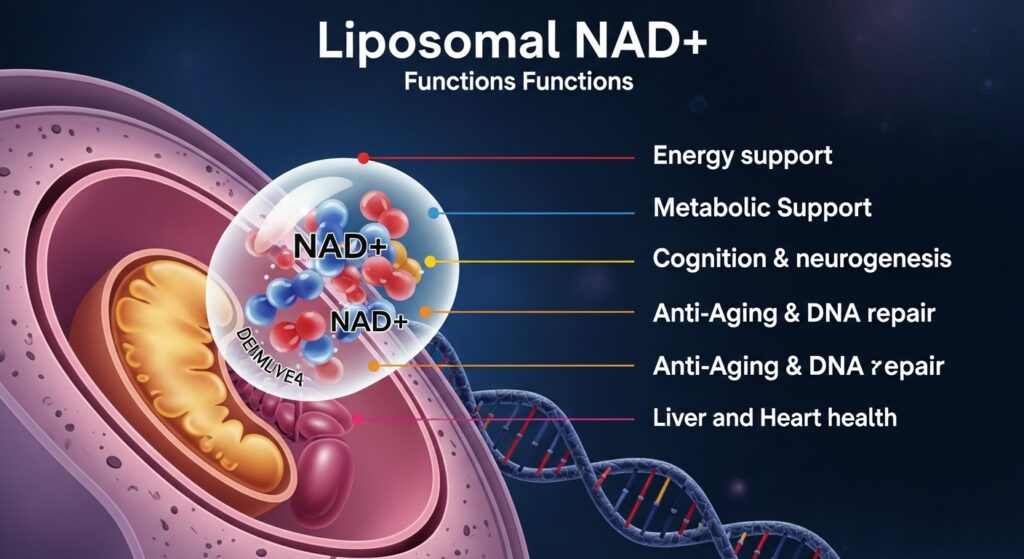Introduction: The Challenge of Delivering NAD+ Effectively
Nicotinamide adenine dinucleotide (NAD+) plays a pivotal role in cellular metabolism, DNA repair, and longevity-associated processes. With age, NAD+ levels naturally decline, leading to decreased mitochondrial function, lower energy levels, and reduced cellular resilience. Although NAD+ precursors such as NMN and NR are popular, directly supplementing NAD+ remains problematic due to its instability and poor gastrointestinal absorption.

1. Why NAD+ Supplements Often Fail
1.1 Poor Oral Stability
NAD+ is chemically unstable in acidic gastric environments. The low pH of the stomach rapidly degrades NAD+ molecules before they reach the intestine. Yoshino et al. (2018) reported that oral NAD+ has a bioavailability of less than 2% due to this degradation.
1.2 Limited Intestinal Uptake
Even if some NAD+ survives the stomach, its large molecular size and polarity limit its ability to cross intestinal epithelial membranes. This makes traditional oral supplementation inefficient (Yoshino et al., 2018).
1.3 Reliance on Precursors
To bypass these issues, most supplements use NAD+ precursors like NMN or NR. However, the body’s ability to convert these precursors into active NAD+ varies depending on age, metabolic health, and enzymatic activity.
2. Liposomal NAD+: A Smarter Delivery System
2.1 Phospholipid Shielding
Liposomal technology encases NAD+ in phospholipid bilayers, mimicking cell membranes. This encapsulation protects the compound from stomach acid and digestive enzymes, improving its stability (Wang et al., 2020).
2.2 Facilitated Absorption
Liposomal vesicles can merge with intestinal cell membranes or be absorbed via endocytosis, allowing for more direct and efficient delivery into systemic circulation.
2.3 Enhanced Efficacy
A 2021 study by Chen et al. found that liposomal NAD+ increased blood NAD+ levels threefold compared to standard forms in aged mice, demonstrating significantly improved bioavailability.

3. Scientific Evidence Supporting Liposomal NAD+
- Wang et al. (2020) demonstrated that over 85% of NAD+ remained intact after 2 hours in simulated gastric fluid when encapsulated in liposomes.
- Studies on related liposomal compounds, such as glutathione and vitamin C, have shown 3–10x improved absorption and stability (Zhang et al., 2022; Park et al., 2019).
- Pharmacokinetic models suggest that liposomal NAD+ can utilize the lymphatic system for enhanced systemic absorption.
4. B2B Insights: Competitive Advantages of Liposomal NAD+
4.1 Product Differentiation
In a competitive nutraceutical market, innovation is key. Liposomal NAD+ offers brands a unique, clinically supported formulation to meet growing consumer demand for effective cellular energy boosters.
4.2 Versatile Formulation Options
Liposomal NAD+ can be integrated into:
- Functional beverages
- Oral liquid sachets
- Softgel or gel-pack capsules
These formats support convenience, bioavailability, and premium positioning.
📎 Related Reading:
- Can CoQ10 Survive Digestion? Liposomal Delivery Offers a Breakthrough
- Is Resveratrol Too Fragile for the Gut? How Liposomal Technology Preserves Its Potency
- Understanding the Absorption Pathways of Oral Liposomes
Conclusion: Liposomal NAD+ Unlocks New Potential
Conventional NAD+ supplements are limited by their low stability and poor absorption. Liposomal delivery systems overcome these barriers, offering improved protection, uptake, and bioavailability. For B2B manufacturers and forward-thinking supplement brands, liposomal NAD+ represents a next-generation innovation with strong clinical rationale and consumer appeal.
References
[1] Yoshino, J., et al. (2018). “NAD+ Intermediates: The Biology and Therapeutic Potential of NMN and NR.” Frontiers in Pharmacology, 9, 978.
[2] Chen, Y., et al. (2021). “Improved oral bioavailability of NAD+ via liposomal encapsulation in aged mice.” Nutrients, 13(11), 3879.
[3] Wang, Q., et al. (2020). “Stability of liposomal NAD+ in simulated gastrointestinal conditions.” International Journal of Pharmaceutics, 586, 119555.
[4] Zhang, J., et al. (2022). “Bioavailability of Liposomal Glutathione in Humans.” Journal of Functional Foods, 90, 104993.
[5] Park, H. J., et al. (2019). “Liposomal Vitamin C Enhances Antioxidant Activity in Human Plasma.” Food Science & Nutrition, 7(8), 2743–2750.